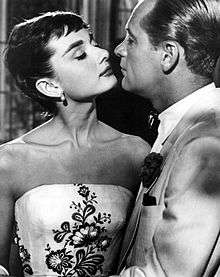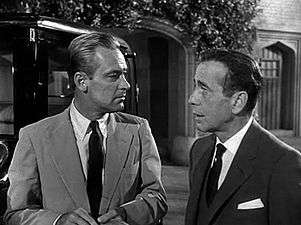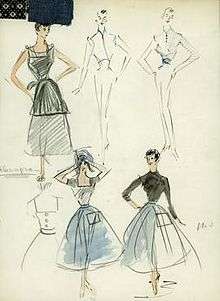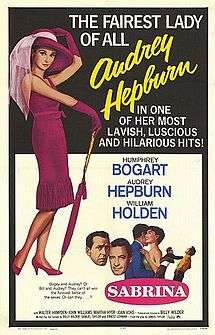Sabrina (1954 film)
| Sabrina | |
|---|---|
|
Theatrical re-release poster | |
| Directed by | Billy Wilder |
| Produced by | Billy Wilder |
| Screenplay by |
Billy Wilder Ernest Lehman Samuel A. Taylor |
| Based on |
Sabrina Fair 1953 play by Samuel A. Taylor |
| Starring |
Humphrey Bogart Audrey Hepburn William Holden |
| Music by | Frederick Hollander |
| Cinematography | Charles Lang |
| Edited by | Arthur P. Schmidt |
| Distributed by | Paramount Pictures |
Release dates | |
Running time | 113 minutes[1] |
| Country | United States |
| Language | English |
| Budget | $2,238,813 |
| Box office | $4 million (rentals)[2] |
Sabrina (Sabrina Fair/"La Vie en Rose" in the United Kingdom) is a 1954 American romantic comedy film directed by Billy Wilder, adapted for the screen by Wilder, Samuel A. Taylor, and Ernest Lehman[3] from Taylor's play Sabrina Fair. It stars Humphrey Bogart, Audrey Hepburn, and William Holden. This was Wilder's last film released by Paramount Pictures, ending a 12-year business relationship with Wilder and the company. The film was selected for preservation in the United States National Film Registry by the Library of Congress in 2002.[4]
Plot

Sabrina Fairchild (Audrey Hepburn) is the young daughter of the Larrabee family's chauffeur, Thomas (John Williams), and she has been in love with David Larrabee (William Holden) all her life. David is an oft-married, idle playboy, crazy for women, who has never noticed Sabrina, much to her and the household staff's dismay. Distraught, she leaves her father a suicide note and tries to kill herself by carbon monoxide poisoning. She fails when David's workaholic older brother, Linus (Humphrey Bogart) intervenes.
Sabrina then attends culinary school in Paris called Mount Douglas, and after 2 years she returns home as an attractive and sophisticated woman. David, after initially not recognizing her, is quickly drawn to her.
Linus sees this and fears that David's imminent marriage to Elizabeth Tyson (Martha Hyer) may be endangered. If the engagement is broken, it would ruin a profitable opportunity on a great corporate merger between Larrabee Industries and Elizabeth's very wealthy father's business. Linus confronts David about his irresponsibility to the family, the business, and Elizabeth, but David is unrepentant.
Linus then tries to distract Sabrina from David by drawing her affections to himself. He succeeds, but in the process falls in love with her, though he cannot admit this even to himself.
Linus reveals his maneuver to Sabrina, leaving her disillusioned about him and David. Sabrina agrees to leave and never come back, and Linus arranges for her to return to Paris by ship the next day.
The next morning, Linus has second thoughts and decides to send David to Paris with Sabrina. This means calling off David's wedding with Elizabeth and the big Tyson deal, and he schedules a meeting of the Larrabee board to announce this. However, David shows up at the meeting and declares that he's decided to marry Elizabeth after all. As a result, Linus finally recognizes his own feelings for Sabrina. He rushes off to join her on the ship, and they sail away together to Paris.
Cast


- Humphrey Bogart as Linus Larrabee
- Audrey Hepburn as Sabrina Fairchild
- William Holden as David Larrabee
- John Williams as Thomas Fairchild, Sabrina's father
- Walter Hampden as Oliver Larrabee, Linus and David's father
- Nella Walker as Maude Larrabee, Linus and David's mother
- Martha Hyer as Elizabeth Tyson, David's fiancée
- Marcel Dalio as Baron St. Fontanel
- Marcel Hillaire as The Professor, Sabrina's culinary instructor
- Ellen Corby as Miss McCardle, Linus' secretary
- Francis X. Bushman as Mr. Tyson, Elizabeth's father
- Joan Vohs as Gretchen Van Horn
- Nancy Kulp as one of the house servants (uncredited)
Production
Initially, Cary Grant was considered for the role of Linus, but he declined,[5] and the role was taken by Bogart, playing against type.
During production of the film, Hepburn and Holden entered into a brief, but passionate and much-publicized love affair. Bogart had originally wanted his wife Lauren Bacall to be cast as Sabrina, and complained that Hepburn required too many takes to get her dialogue right and pointed out her inexperience.[6] His behavior towards Hepburn, however, was better than his behavior towards other members of the cast and crew.
Bogart was very unhappy during the filming, convinced that he was totally wrong for this kind of film, mad at not being Wilder's first choice, and not liking Holden or Wilder. But Wilder's offbeat casting produced a performance that critics generally considered successful. Bogart later apologized to Wilder for his behavior on-set, citing problems in his personal life.
Wilder began shooting before the script was finished, and Lehman was writing all day to complete it. Eventually, he would finish a scene in the morning, deliver it during lunch, and filming of it would begin in the afternoon.[6]
Although Edith Head won an Oscar for Best Costumes, most of Hepburn's outfits are rumored to have been created by Hubert de Givenchy and chosen personally by the star. Head, as the film's official costume designer, was given credit for the costumes, although the Academy's votes were obviously for Hepburn's attire.[7] Edith Head did not refuse the Oscar. In a 1974 interview, Head stated that she was responsible for creating the dresses, with inspiration from some Givenchy designs that Hepburn liked, but that she made important changes, and the dresses were not by Givenchy.[8] After Head's death, Givenchy stated that Sabrina's iconic black cocktail dress was produced at Paramount under Head's supervision, but claimed it was his design.[9]
The film began a lifelong association between Givenchy and Hepburn. It has been reported that when Hepburn called on Givenchy for the first time in Paris, he assumed that it was Katharine Hepburn in his salon.[10]
The location used to portray the Larrabee family's mansion in Glen Cove, New York, was 'Hill Grove', the home of George Lewis in Beverly Hills, California.[11] This mansion was later demolished during the 1960s. The location used to portray the Glen Cove train station was Glen Cove (LIRR station), which is a train station along the Oyster Bay Branch of the Long Island Rail Road.[11] The building at 30 Broad Street in Manhattan's financial district was used as the location for the headquarters of the Larrabee company.[11]
La Vie en rose
Hepburn sings, in French, "La Vie en rose" (a reference to seeing the world through rose-colored glasses), the signature song of French singer Édith Piaf—which had been highly popular in the English-speaking world as well as in France. The occasion for Hepburn to sing it is at the episode of Sabrina's return from Paris, when she is far more assertive than before setting out, and her life does turn rosier.
Awards

- Wins
- Nominations
- Academy Award for Best Director - Billy Wilder
- Academy Award for Best Actress - Audrey Hepburn
- Academy Award for Best Art Direction (Black-and-White) - (Art Direction) Hal Pereira and Walter Tyler; (Set Decoration) Sam Comer and Ray Moyer
- Academy Award for Best Cinematography (Black-and-White) - Charles Lang, Jr.
- Academy Award for Best Adapted Screenplay - Billy Wilder, Samuel A. Taylor and Ernest Lehman
Remakes
In 1995 a remake was produced, starring Harrison Ford, Julia Ormond, and Greg Kinnear in the roles originally played by Bogart, Hepburn, and Holden respectively. It was directed by Sydney Pollack.[13]
It also served as the inspiration for the 1994 Hindi film Yeh Dillagi, starring Akshay Kumar, Kajol and Saif Ali Khan. While there are changes to the plot, it was a considerable success at the box office. It also boosted the careers of Akshay Kumar and Kajol, both of whom got best actor nominations at the Filmfare Awards for their performances.
Manappandal (1961) was inspired by this movie in Tamil. It featured S.S.Rajendran, S.A. Ashokan and B.Saroja Devi. It was a box-office success and ran for 100 days in many cinemas.[14] It was also remade in Telugu as Intiki Deepam Illaley, featuring N.T. Ramarao, Kongara Jaggaiah and B. Saroja Devi.
References
- ↑ "SABRINA FAIR (U)". British Board of Film Classification. 1954-03-29. Retrieved 2012-12-09.
- ↑ 'The Top Box-Office Hits of 1954', Variety Weekly, January 5, 1955
- ↑ "Sabrina". Turner Classic Movies. Atlanta: Turner Broadcasting System (Time Warner). Retrieved September 6, 2016.
- ↑ "Films Selected for the National Film Registry in 2002 (January 2003) - Library of Congress Information Bulletin".
- ↑ Jaynes, Barbara Grant; Trachtenberg, Robert. Cary Grant: A Class Apart. Burbank, California: Turner Classic Movies (TCM) and Turner Entertainment. 2004.
- 1 2 Ben Mankiewicz of Turner Classic Movies.
- ↑ "kartanonrouva.net".
- ↑ Dorléac, Jean-Pierre (2010-10-24). "Edith Head and the 'Sabrina' dress". Los Angeles Times.
- ↑ "Style on Film: Sabrina". 20 March 2011.
- ↑ "On This Day In Fashion".
- 1 2 3 "Sabrina 1954 film locations". The Worldwide Guide To Movie Locations. Retrieved February 20, 2016.
- ↑ "NY Times: Sabrina". NY Times. Retrieved 2008-12-21.
- ↑ "Sabrina 1995". Turner Classic Movies. Atlanta: Turner Broadcasting System (Time Warner). Retrieved September 6, 2016.
- ↑ Guy, Randor. "Manappandal". The Hindu. Retrieved 27 April 2014.
- Further reading
- Shaw, Mark; Juliet Cuming; David Taylor (2009-04-14). Charmed by Audrey: Life on the Set of Sabrina. San Rafael, CA: Insight Editions. ISBN 978-1-933784-87-8. (Candid photographs of Audrey, on and off the set, taken by Mark Shaw for LIFE magazine during production of the film.)
- Shaw, Mark (photographer) (1953-12-07). "Audrey Hepburn, Many-sided Charmer". LIFE. Time, Inc. 35 (23): 127–135. (LIFE article on Audrey including some of the photos from the Sabrina set.)
External links
| Wikiquote has quotations related to: Sabrina (1954 film) |
| Wikimedia Commons has media related to Sabrina. |
- Sabrina at the Internet Movie Database
- Sabrina at AllMovie
- Sabrina at the TCM Movie Database
- Sabrina at the American Film Institute Catalog
- Sabrina at Metacritic
- Reel Classics page includes a Sabrina poster and Hepburn's photo from the film

